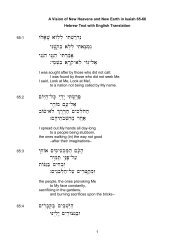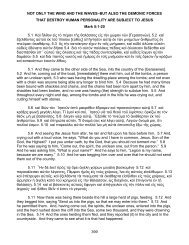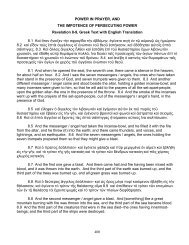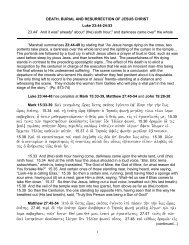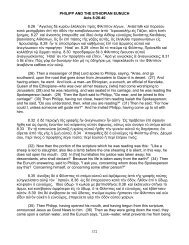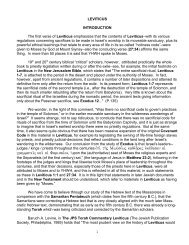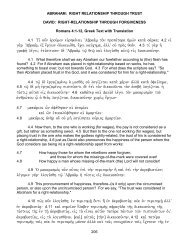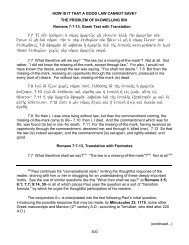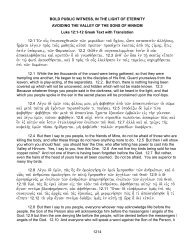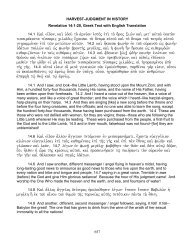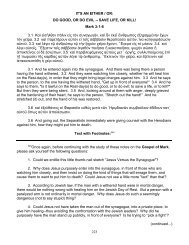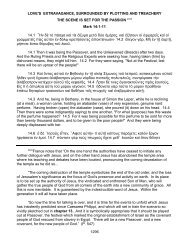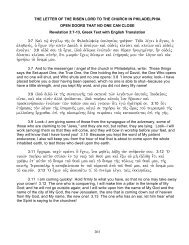Revelation 20 - In Depth Bible Commentaries
Revelation 20 - In Depth Bible Commentaries
Revelation 20 - In Depth Bible Commentaries
Create successful ePaper yourself
Turn your PDF publications into a flip-book with our unique Google optimized e-Paper software.
2264 2265 2266 2267 2268 2269<br />
dragon, the serpent, the ancient one, which is accuser / devil and the adversary<br />
2261<br />
(...continued)<br />
thought of as being bound with a literal chain. This is obviously symbolical language, and is<br />
rooted in Greek mythological views of the place of punishment of the wicked!<br />
Aune comments that “The use of chains to bind satan and his host is an apocalyptic<br />
motif (1 Enoch 54:3-5; 2 Apocalypse Baruch 56:13; Sibylline Oracles 2.289; Jude 6; 2<br />
Peter 2:4) derived from earlier Greek traditions...of the chaining of the...‘hundred-handed<br />
ones’...and the titans in tartarus...[as well as] the chaining of Prometheus...” (P. 1081)<br />
Jude 6, “And the angels who did not keep their positions of authority but abandoned<br />
their own home--these He has kept in darkness, bound with everlasting chains for judgment on<br />
the great Day.”<br />
2 Peter 2:4, “...God did not spare angels when they sinned, but [seirai/j zo,fou tartarw,saj]<br />
with cords of darkness placing (them) in Tartarus [thought of by the Greeks as a subterranean<br />
place lower than hades, where divine punishment is meted out, and so regarded in<br />
Israelite apocalyptic literature as well], to be held for judgment.”<br />
There can be little doubt that in these two New Testament passages, Greek mythological<br />
views are being taken up, and used to warn Christians of the dangers of apostasy–views<br />
such as those expressed in the following two passages:<br />
1 Enoch 54:1-5, “I looked...and saw...a valley, deep and burning with fire. And they<br />
were bringing kings and potentates and were throwing them into this deep valley. And my<br />
eyes saw there their chains while they were making them into iron fetters of immense weight...<br />
being prepared for the armies of Azaz’el [one of the fallen angels / messengers], in order that<br />
they may take them and cast them into the abyss of complete condemnation...”<br />
Sibylline Oracles 2.285-92, “...An undying river flows in a circle. All these (sorcerers<br />
and sorceresses)...the angels / messengers of the immortal, everlasting God will punish terribly<br />
from above with whips of flame, having bound them around with fiery chains and unbreakable<br />
bonds. Then, in the dead of the night, they will be thrown under many terrible infernal<br />
beasts in gehenna [the biblical background of the Valley of Hinnom’s sons, on the south<br />
side of Jerusalem, has been abandoned, and the name has been applied to the Greek mythological<br />
view of the place of eternal punishment], where there is immeasurable darkness.”<br />
2262<br />
Somewhat strangely, the Greek text states that the chain was "upon" the hand of the<br />
messenger / angel, rather than being "in" his hand. However, in Greek the word "hand" sometimes<br />
refers to the wrist or lower arm, and it may be that John means the chain was draped<br />
over the messenger’s / angel's arm. Perhaps because of the strangeness of the phrase, Sinaiticus,<br />
Minuscule 1611 and a few other Greek manuscripts change the reading to ev vn th| / ceiri,<br />
en te cheiri, “in the hand.” But the variant reading does not change the meaning of <strong>Revelation</strong>.<br />
Aune translates by “in his hand” (P. 1071).<br />
2263<br />
Aune translates by “apprehended” (p. 1071).<br />
987



